Analysis of Project Management Challenges at Fletcher Building
VerifiedAdded on 2021/01/01
|19
|4933
|190
Project
AI Summary
This project report examines the project management challenges faced by Fletcher Building, a major construction company in New Zealand. The report identifies time and cost overruns as core issues affecting the organization's construction projects. It highlights problems within the communication hierarchy, particularly between suppliers and the project manager, leading to delays. The analysis also points to discrepancies between project managers and financial executives regarding budgeting and cost management. The report proposes several solutions, including restructuring the organizational structure, clearly defining roles and responsibilities for team members, and providing project managers with financial expertise. The study includes a literature review of the construction industry and the issues it faces, as well as an analysis of the company's existing structure. The report concludes with recommendations to improve project outcomes and overall organizational effectiveness. The goal is to help Fletcher Building improve its project management strategies, reduce delays, and control costs to maintain its reputation and competitiveness.

PROJECT ANALYSIS
Paraphrase This Document
Need a fresh take? Get an instant paraphrase of this document with our AI Paraphraser
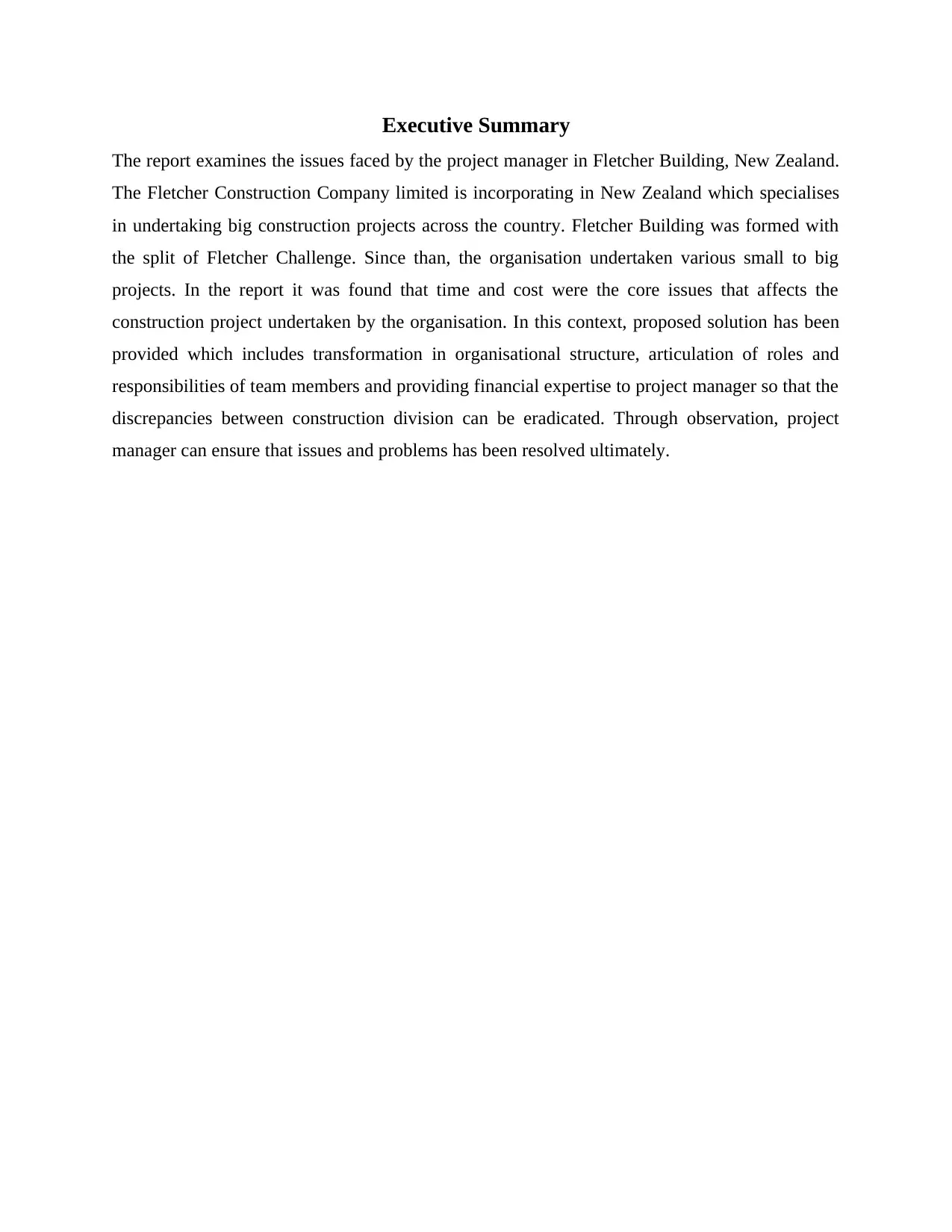
Executive Summary
The report examines the issues faced by the project manager in Fletcher Building, New Zealand.
The Fletcher Construction Company limited is incorporating in New Zealand which specialises
in undertaking big construction projects across the country. Fletcher Building was formed with
the split of Fletcher Challenge. Since than, the organisation undertaken various small to big
projects. In the report it was found that time and cost were the core issues that affects the
construction project undertaken by the organisation. In this context, proposed solution has been
provided which includes transformation in organisational structure, articulation of roles and
responsibilities of team members and providing financial expertise to project manager so that the
discrepancies between construction division can be eradicated. Through observation, project
manager can ensure that issues and problems has been resolved ultimately.
The report examines the issues faced by the project manager in Fletcher Building, New Zealand.
The Fletcher Construction Company limited is incorporating in New Zealand which specialises
in undertaking big construction projects across the country. Fletcher Building was formed with
the split of Fletcher Challenge. Since than, the organisation undertaken various small to big
projects. In the report it was found that time and cost were the core issues that affects the
construction project undertaken by the organisation. In this context, proposed solution has been
provided which includes transformation in organisational structure, articulation of roles and
responsibilities of team members and providing financial expertise to project manager so that the
discrepancies between construction division can be eradicated. Through observation, project
manager can ensure that issues and problems has been resolved ultimately.
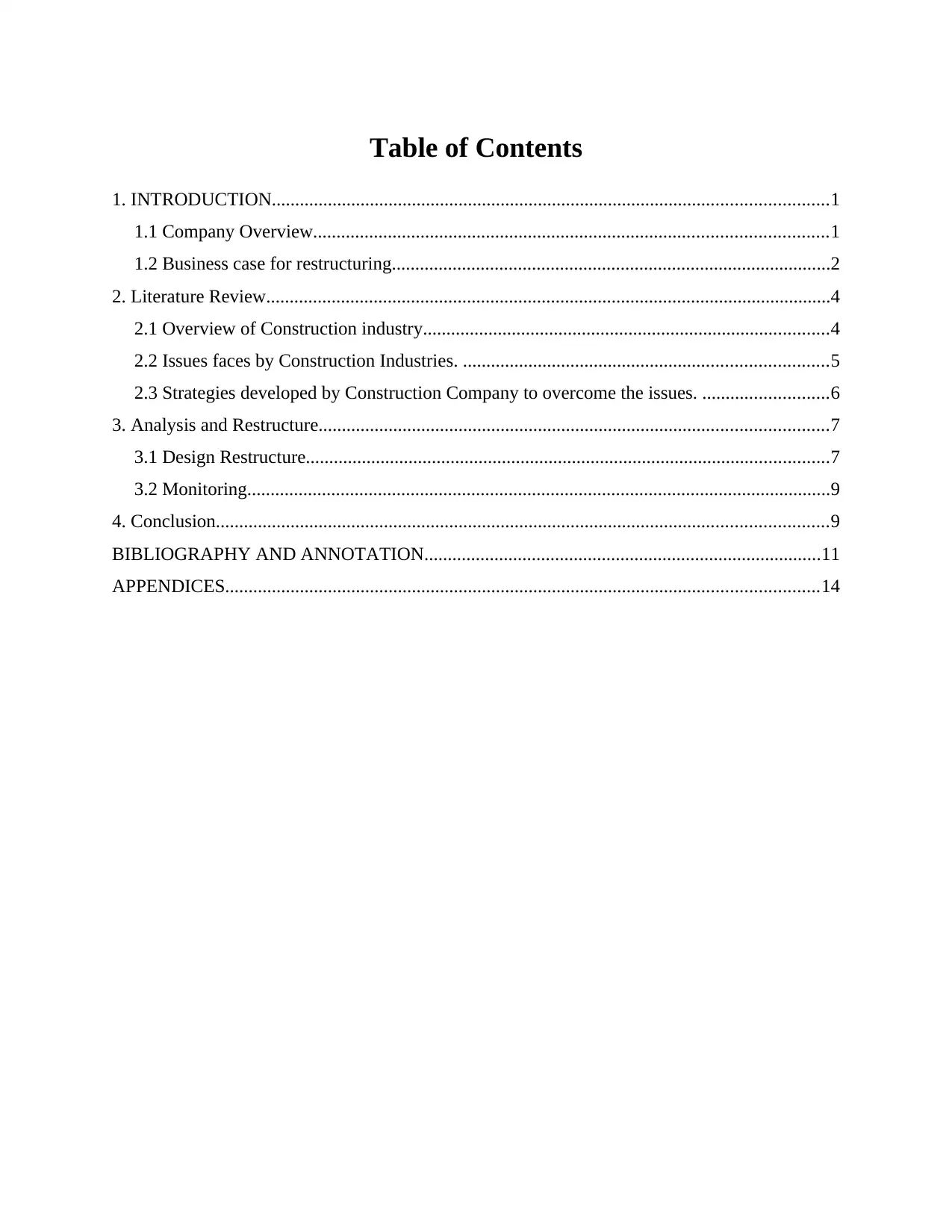
Table of Contents
1. INTRODUCTION.......................................................................................................................1
1.1 Company Overview..............................................................................................................1
1.2 Business case for restructuring..............................................................................................2
2. Literature Review.........................................................................................................................4
2.1 Overview of Construction industry.......................................................................................4
2.2 Issues faces by Construction Industries. ..............................................................................5
2.3 Strategies developed by Construction Company to overcome the issues. ...........................6
3. Analysis and Restructure.............................................................................................................7
3.1 Design Restructure................................................................................................................7
3.2 Monitoring.............................................................................................................................9
4. Conclusion...................................................................................................................................9
BIBLIOGRAPHY AND ANNOTATION.....................................................................................11
APPENDICES...............................................................................................................................14
1. INTRODUCTION.......................................................................................................................1
1.1 Company Overview..............................................................................................................1
1.2 Business case for restructuring..............................................................................................2
2. Literature Review.........................................................................................................................4
2.1 Overview of Construction industry.......................................................................................4
2.2 Issues faces by Construction Industries. ..............................................................................5
2.3 Strategies developed by Construction Company to overcome the issues. ...........................6
3. Analysis and Restructure.............................................................................................................7
3.1 Design Restructure................................................................................................................7
3.2 Monitoring.............................................................................................................................9
4. Conclusion...................................................................................................................................9
BIBLIOGRAPHY AND ANNOTATION.....................................................................................11
APPENDICES...............................................................................................................................14
⊘ This is a preview!⊘
Do you want full access?
Subscribe today to unlock all pages.

Trusted by 1+ million students worldwide
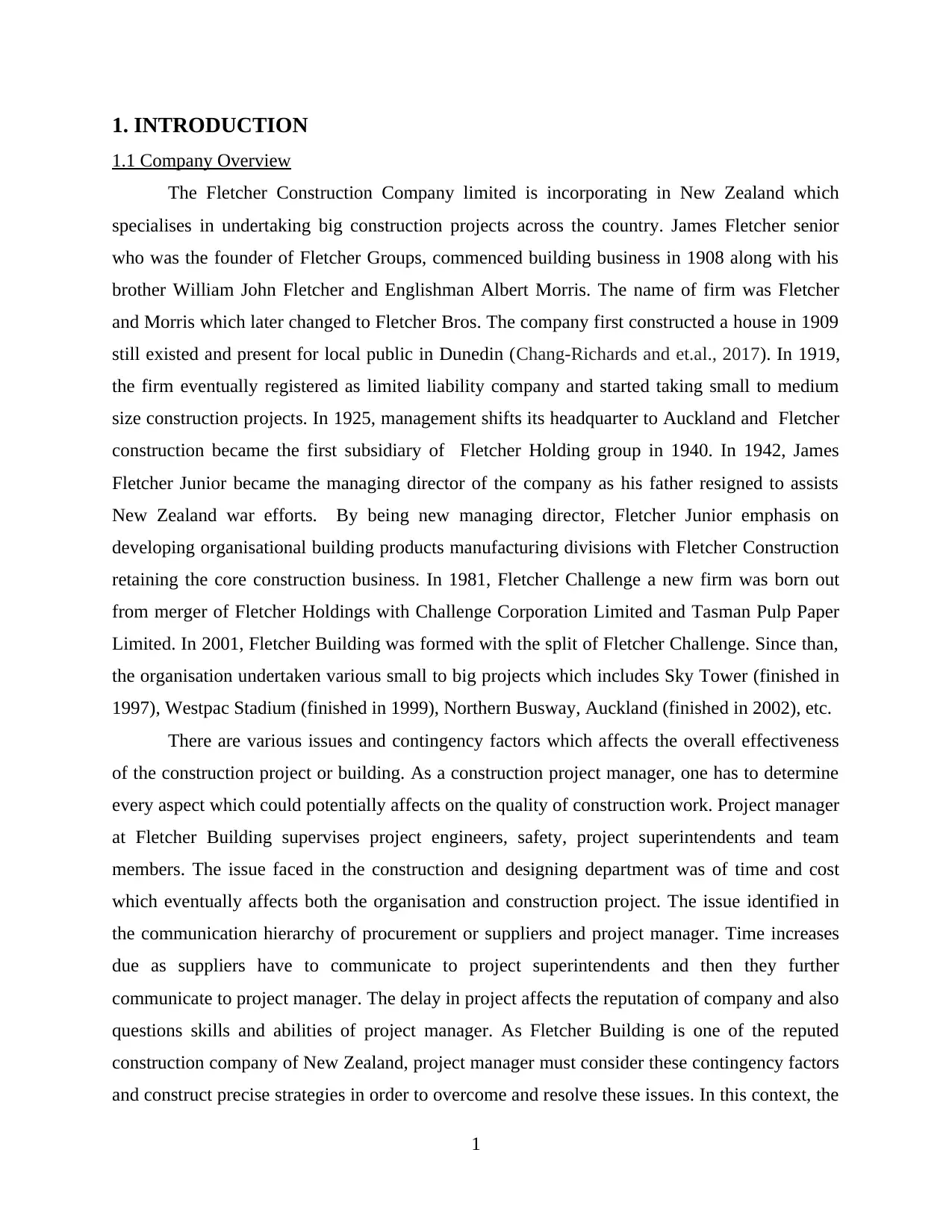
1. INTRODUCTION
1.1 Company Overview
The Fletcher Construction Company limited is incorporating in New Zealand which
specialises in undertaking big construction projects across the country. James Fletcher senior
who was the founder of Fletcher Groups, commenced building business in 1908 along with his
brother William John Fletcher and Englishman Albert Morris. The name of firm was Fletcher
and Morris which later changed to Fletcher Bros. The company first constructed a house in 1909
still existed and present for local public in Dunedin (Chang-Richards and et.al., 2017). In 1919,
the firm eventually registered as limited liability company and started taking small to medium
size construction projects. In 1925, management shifts its headquarter to Auckland and Fletcher
construction became the first subsidiary of Fletcher Holding group in 1940. In 1942, James
Fletcher Junior became the managing director of the company as his father resigned to assists
New Zealand war efforts. By being new managing director, Fletcher Junior emphasis on
developing organisational building products manufacturing divisions with Fletcher Construction
retaining the core construction business. In 1981, Fletcher Challenge a new firm was born out
from merger of Fletcher Holdings with Challenge Corporation Limited and Tasman Pulp Paper
Limited. In 2001, Fletcher Building was formed with the split of Fletcher Challenge. Since than,
the organisation undertaken various small to big projects which includes Sky Tower (finished in
1997), Westpac Stadium (finished in 1999), Northern Busway, Auckland (finished in 2002), etc.
There are various issues and contingency factors which affects the overall effectiveness
of the construction project or building. As a construction project manager, one has to determine
every aspect which could potentially affects on the quality of construction work. Project manager
at Fletcher Building supervises project engineers, safety, project superintendents and team
members. The issue faced in the construction and designing department was of time and cost
which eventually affects both the organisation and construction project. The issue identified in
the communication hierarchy of procurement or suppliers and project manager. Time increases
due as suppliers have to communicate to project superintendents and then they further
communicate to project manager. The delay in project affects the reputation of company and also
questions skills and abilities of project manager. As Fletcher Building is one of the reputed
construction company of New Zealand, project manager must consider these contingency factors
and construct precise strategies in order to overcome and resolve these issues. In this context, the
1
1.1 Company Overview
The Fletcher Construction Company limited is incorporating in New Zealand which
specialises in undertaking big construction projects across the country. James Fletcher senior
who was the founder of Fletcher Groups, commenced building business in 1908 along with his
brother William John Fletcher and Englishman Albert Morris. The name of firm was Fletcher
and Morris which later changed to Fletcher Bros. The company first constructed a house in 1909
still existed and present for local public in Dunedin (Chang-Richards and et.al., 2017). In 1919,
the firm eventually registered as limited liability company and started taking small to medium
size construction projects. In 1925, management shifts its headquarter to Auckland and Fletcher
construction became the first subsidiary of Fletcher Holding group in 1940. In 1942, James
Fletcher Junior became the managing director of the company as his father resigned to assists
New Zealand war efforts. By being new managing director, Fletcher Junior emphasis on
developing organisational building products manufacturing divisions with Fletcher Construction
retaining the core construction business. In 1981, Fletcher Challenge a new firm was born out
from merger of Fletcher Holdings with Challenge Corporation Limited and Tasman Pulp Paper
Limited. In 2001, Fletcher Building was formed with the split of Fletcher Challenge. Since than,
the organisation undertaken various small to big projects which includes Sky Tower (finished in
1997), Westpac Stadium (finished in 1999), Northern Busway, Auckland (finished in 2002), etc.
There are various issues and contingency factors which affects the overall effectiveness
of the construction project or building. As a construction project manager, one has to determine
every aspect which could potentially affects on the quality of construction work. Project manager
at Fletcher Building supervises project engineers, safety, project superintendents and team
members. The issue faced in the construction and designing department was of time and cost
which eventually affects both the organisation and construction project. The issue identified in
the communication hierarchy of procurement or suppliers and project manager. Time increases
due as suppliers have to communicate to project superintendents and then they further
communicate to project manager. The delay in project affects the reputation of company and also
questions skills and abilities of project manager. As Fletcher Building is one of the reputed
construction company of New Zealand, project manager must consider these contingency factors
and construct precise strategies in order to overcome and resolve these issues. In this context, the
1
Paraphrase This Document
Need a fresh take? Get an instant paraphrase of this document with our AI Paraphraser
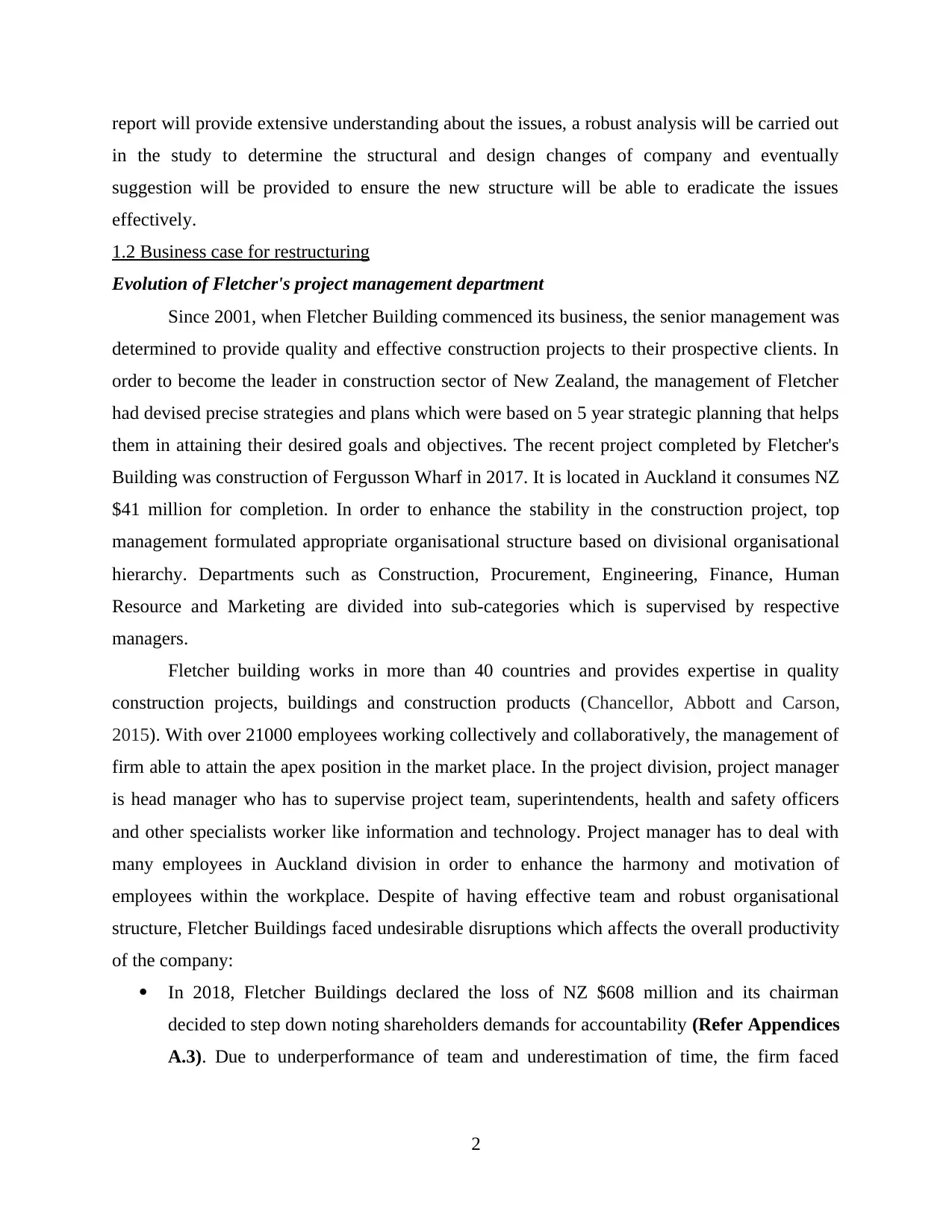
report will provide extensive understanding about the issues, a robust analysis will be carried out
in the study to determine the structural and design changes of company and eventually
suggestion will be provided to ensure the new structure will be able to eradicate the issues
effectively.
1.2 Business case for restructuring
Evolution of Fletcher's project management department
Since 2001, when Fletcher Building commenced its business, the senior management was
determined to provide quality and effective construction projects to their prospective clients. In
order to become the leader in construction sector of New Zealand, the management of Fletcher
had devised precise strategies and plans which were based on 5 year strategic planning that helps
them in attaining their desired goals and objectives. The recent project completed by Fletcher's
Building was construction of Fergusson Wharf in 2017. It is located in Auckland it consumes NZ
$41 million for completion. In order to enhance the stability in the construction project, top
management formulated appropriate organisational structure based on divisional organisational
hierarchy. Departments such as Construction, Procurement, Engineering, Finance, Human
Resource and Marketing are divided into sub-categories which is supervised by respective
managers.
Fletcher building works in more than 40 countries and provides expertise in quality
construction projects, buildings and construction products (Chancellor, Abbott and Carson,
2015). With over 21000 employees working collectively and collaboratively, the management of
firm able to attain the apex position in the market place. In the project division, project manager
is head manager who has to supervise project team, superintendents, health and safety officers
and other specialists worker like information and technology. Project manager has to deal with
many employees in Auckland division in order to enhance the harmony and motivation of
employees within the workplace. Despite of having effective team and robust organisational
structure, Fletcher Buildings faced undesirable disruptions which affects the overall productivity
of the company:
In 2018, Fletcher Buildings declared the loss of NZ $608 million and its chairman
decided to step down noting shareholders demands for accountability (Refer Appendices
A.3). Due to underperformance of team and underestimation of time, the firm faced
2
in the study to determine the structural and design changes of company and eventually
suggestion will be provided to ensure the new structure will be able to eradicate the issues
effectively.
1.2 Business case for restructuring
Evolution of Fletcher's project management department
Since 2001, when Fletcher Building commenced its business, the senior management was
determined to provide quality and effective construction projects to their prospective clients. In
order to become the leader in construction sector of New Zealand, the management of Fletcher
had devised precise strategies and plans which were based on 5 year strategic planning that helps
them in attaining their desired goals and objectives. The recent project completed by Fletcher's
Building was construction of Fergusson Wharf in 2017. It is located in Auckland it consumes NZ
$41 million for completion. In order to enhance the stability in the construction project, top
management formulated appropriate organisational structure based on divisional organisational
hierarchy. Departments such as Construction, Procurement, Engineering, Finance, Human
Resource and Marketing are divided into sub-categories which is supervised by respective
managers.
Fletcher building works in more than 40 countries and provides expertise in quality
construction projects, buildings and construction products (Chancellor, Abbott and Carson,
2015). With over 21000 employees working collectively and collaboratively, the management of
firm able to attain the apex position in the market place. In the project division, project manager
is head manager who has to supervise project team, superintendents, health and safety officers
and other specialists worker like information and technology. Project manager has to deal with
many employees in Auckland division in order to enhance the harmony and motivation of
employees within the workplace. Despite of having effective team and robust organisational
structure, Fletcher Buildings faced undesirable disruptions which affects the overall productivity
of the company:
In 2018, Fletcher Buildings declared the loss of NZ $608 million and its chairman
decided to step down noting shareholders demands for accountability (Refer Appendices
A.3). Due to underperformance of team and underestimation of time, the firm faced
2
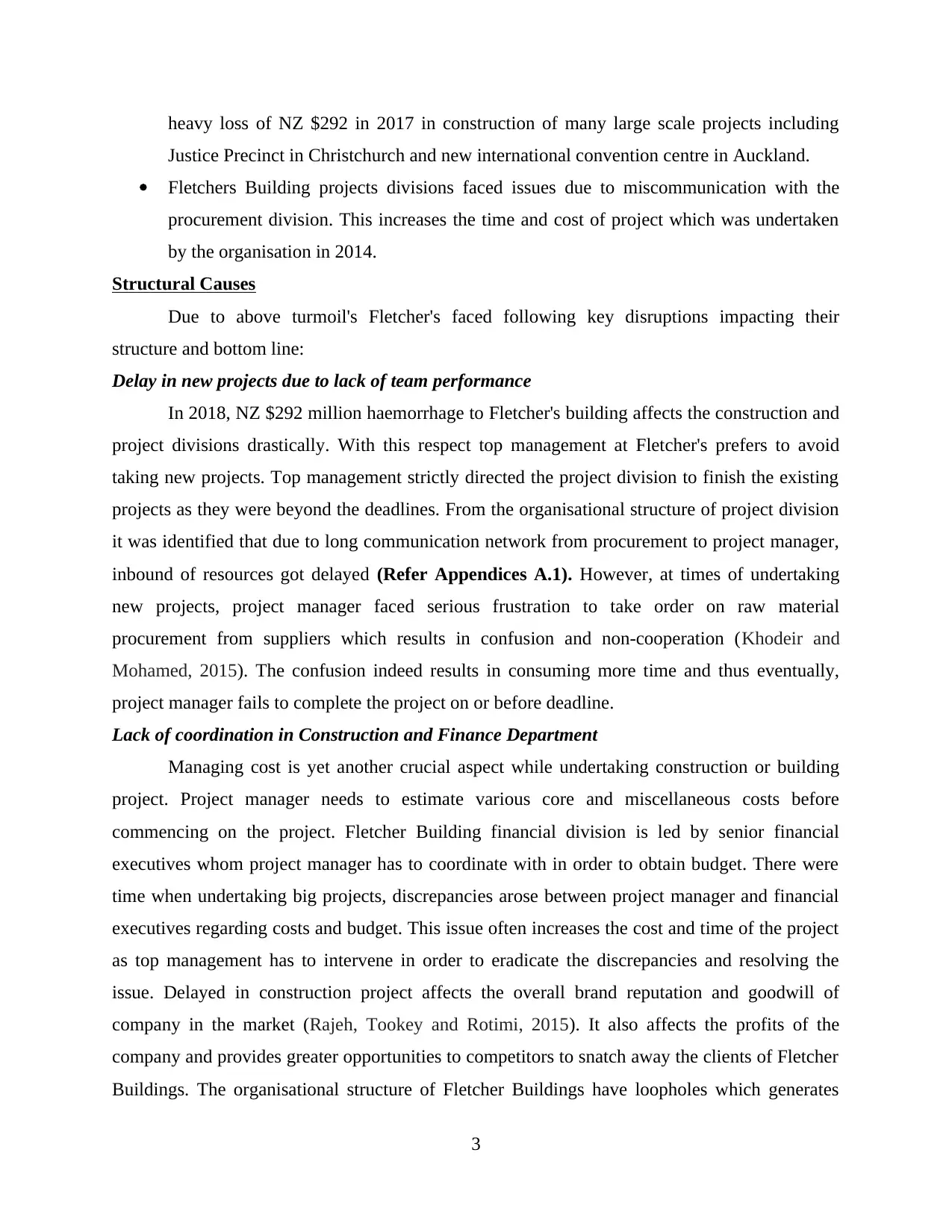
heavy loss of NZ $292 in 2017 in construction of many large scale projects including
Justice Precinct in Christchurch and new international convention centre in Auckland.
Fletchers Building projects divisions faced issues due to miscommunication with the
procurement division. This increases the time and cost of project which was undertaken
by the organisation in 2014.
Structural Causes
Due to above turmoil's Fletcher's faced following key disruptions impacting their
structure and bottom line:
Delay in new projects due to lack of team performance
In 2018, NZ $292 million haemorrhage to Fletcher's building affects the construction and
project divisions drastically. With this respect top management at Fletcher's prefers to avoid
taking new projects. Top management strictly directed the project division to finish the existing
projects as they were beyond the deadlines. From the organisational structure of project division
it was identified that due to long communication network from procurement to project manager,
inbound of resources got delayed (Refer Appendices A.1). However, at times of undertaking
new projects, project manager faced serious frustration to take order on raw material
procurement from suppliers which results in confusion and non-cooperation (Khodeir and
Mohamed, 2015). The confusion indeed results in consuming more time and thus eventually,
project manager fails to complete the project on or before deadline.
Lack of coordination in Construction and Finance Department
Managing cost is yet another crucial aspect while undertaking construction or building
project. Project manager needs to estimate various core and miscellaneous costs before
commencing on the project. Fletcher Building financial division is led by senior financial
executives whom project manager has to coordinate with in order to obtain budget. There were
time when undertaking big projects, discrepancies arose between project manager and financial
executives regarding costs and budget. This issue often increases the cost and time of the project
as top management has to intervene in order to eradicate the discrepancies and resolving the
issue. Delayed in construction project affects the overall brand reputation and goodwill of
company in the market (Rajeh, Tookey and Rotimi, 2015). It also affects the profits of the
company and provides greater opportunities to competitors to snatch away the clients of Fletcher
Buildings. The organisational structure of Fletcher Buildings have loopholes which generates
3
Justice Precinct in Christchurch and new international convention centre in Auckland.
Fletchers Building projects divisions faced issues due to miscommunication with the
procurement division. This increases the time and cost of project which was undertaken
by the organisation in 2014.
Structural Causes
Due to above turmoil's Fletcher's faced following key disruptions impacting their
structure and bottom line:
Delay in new projects due to lack of team performance
In 2018, NZ $292 million haemorrhage to Fletcher's building affects the construction and
project divisions drastically. With this respect top management at Fletcher's prefers to avoid
taking new projects. Top management strictly directed the project division to finish the existing
projects as they were beyond the deadlines. From the organisational structure of project division
it was identified that due to long communication network from procurement to project manager,
inbound of resources got delayed (Refer Appendices A.1). However, at times of undertaking
new projects, project manager faced serious frustration to take order on raw material
procurement from suppliers which results in confusion and non-cooperation (Khodeir and
Mohamed, 2015). The confusion indeed results in consuming more time and thus eventually,
project manager fails to complete the project on or before deadline.
Lack of coordination in Construction and Finance Department
Managing cost is yet another crucial aspect while undertaking construction or building
project. Project manager needs to estimate various core and miscellaneous costs before
commencing on the project. Fletcher Building financial division is led by senior financial
executives whom project manager has to coordinate with in order to obtain budget. There were
time when undertaking big projects, discrepancies arose between project manager and financial
executives regarding costs and budget. This issue often increases the cost and time of the project
as top management has to intervene in order to eradicate the discrepancies and resolving the
issue. Delayed in construction project affects the overall brand reputation and goodwill of
company in the market (Rajeh, Tookey and Rotimi, 2015). It also affects the profits of the
company and provides greater opportunities to competitors to snatch away the clients of Fletcher
Buildings. The organisational structure of Fletcher Buildings have loopholes which generates
3
⊘ This is a preview!⊘
Do you want full access?
Subscribe today to unlock all pages.

Trusted by 1+ million students worldwide
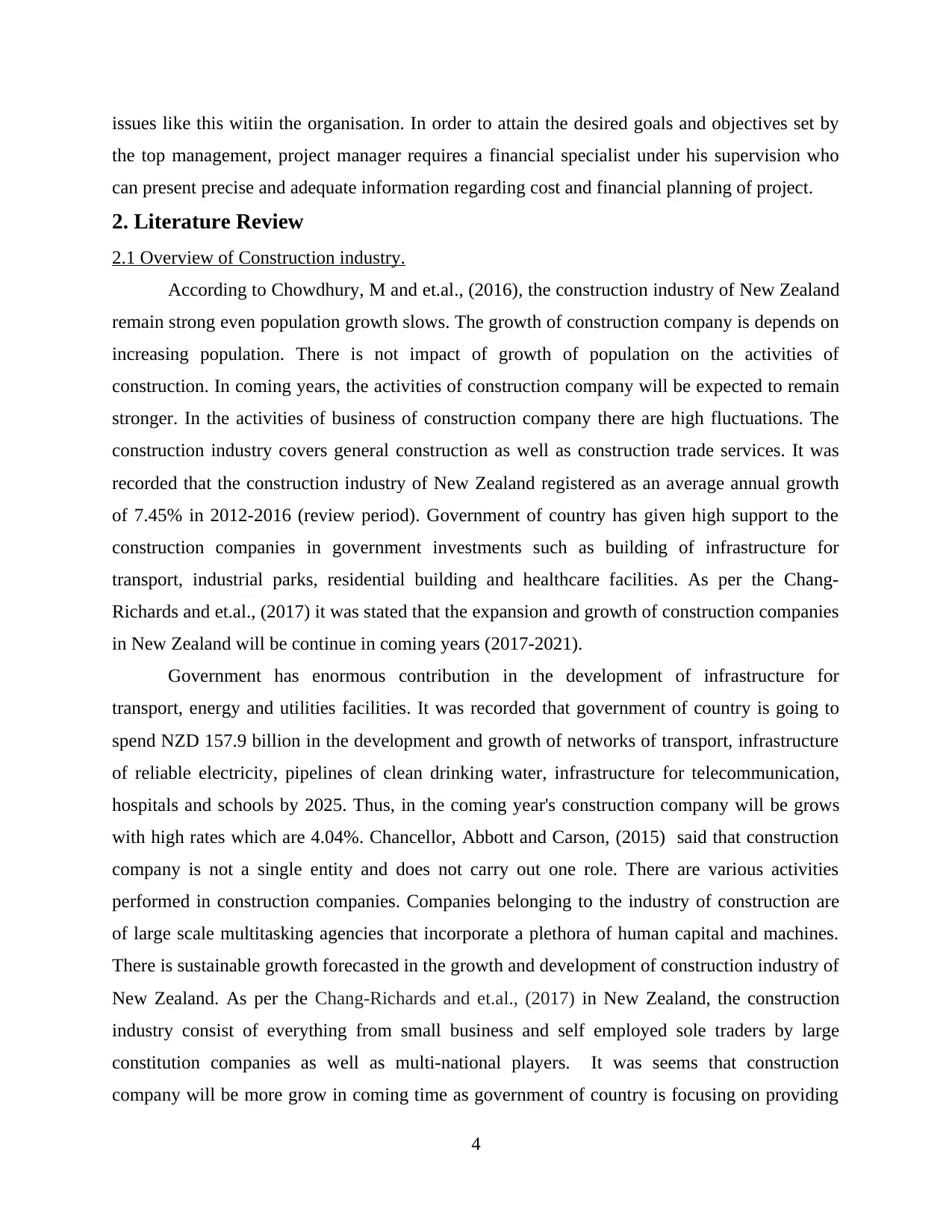
issues like this witiin the organisation. In order to attain the desired goals and objectives set by
the top management, project manager requires a financial specialist under his supervision who
can present precise and adequate information regarding cost and financial planning of project.
2. Literature Review
2.1 Overview of Construction industry.
According to Chowdhury, M and et.al., (2016), the construction industry of New Zealand
remain strong even population growth slows. The growth of construction company is depends on
increasing population. There is not impact of growth of population on the activities of
construction. In coming years, the activities of construction company will be expected to remain
stronger. In the activities of business of construction company there are high fluctuations. The
construction industry covers general construction as well as construction trade services. It was
recorded that the construction industry of New Zealand registered as an average annual growth
of 7.45% in 2012-2016 (review period). Government of country has given high support to the
construction companies in government investments such as building of infrastructure for
transport, industrial parks, residential building and healthcare facilities. As per the Chang-
Richards and et.al., (2017) it was stated that the expansion and growth of construction companies
in New Zealand will be continue in coming years (2017-2021).
Government has enormous contribution in the development of infrastructure for
transport, energy and utilities facilities. It was recorded that government of country is going to
spend NZD 157.9 billion in the development and growth of networks of transport, infrastructure
of reliable electricity, pipelines of clean drinking water, infrastructure for telecommunication,
hospitals and schools by 2025. Thus, in the coming year's construction company will be grows
with high rates which are 4.04%. Chancellor, Abbott and Carson, (2015) said that construction
company is not a single entity and does not carry out one role. There are various activities
performed in construction companies. Companies belonging to the industry of construction are
of large scale multitasking agencies that incorporate a plethora of human capital and machines.
There is sustainable growth forecasted in the growth and development of construction industry of
New Zealand. As per the Chang-Richards and et.al., (2017) in New Zealand, the construction
industry consist of everything from small business and self employed sole traders by large
constitution companies as well as multi-national players. It was seems that construction
company will be more grow in coming time as government of country is focusing on providing
4
the top management, project manager requires a financial specialist under his supervision who
can present precise and adequate information regarding cost and financial planning of project.
2. Literature Review
2.1 Overview of Construction industry.
According to Chowdhury, M and et.al., (2016), the construction industry of New Zealand
remain strong even population growth slows. The growth of construction company is depends on
increasing population. There is not impact of growth of population on the activities of
construction. In coming years, the activities of construction company will be expected to remain
stronger. In the activities of business of construction company there are high fluctuations. The
construction industry covers general construction as well as construction trade services. It was
recorded that the construction industry of New Zealand registered as an average annual growth
of 7.45% in 2012-2016 (review period). Government of country has given high support to the
construction companies in government investments such as building of infrastructure for
transport, industrial parks, residential building and healthcare facilities. As per the Chang-
Richards and et.al., (2017) it was stated that the expansion and growth of construction companies
in New Zealand will be continue in coming years (2017-2021).
Government has enormous contribution in the development of infrastructure for
transport, energy and utilities facilities. It was recorded that government of country is going to
spend NZD 157.9 billion in the development and growth of networks of transport, infrastructure
of reliable electricity, pipelines of clean drinking water, infrastructure for telecommunication,
hospitals and schools by 2025. Thus, in the coming year's construction company will be grows
with high rates which are 4.04%. Chancellor, Abbott and Carson, (2015) said that construction
company is not a single entity and does not carry out one role. There are various activities
performed in construction companies. Companies belonging to the industry of construction are
of large scale multitasking agencies that incorporate a plethora of human capital and machines.
There is sustainable growth forecasted in the growth and development of construction industry of
New Zealand. As per the Chang-Richards and et.al., (2017) in New Zealand, the construction
industry consist of everything from small business and self employed sole traders by large
constitution companies as well as multi-national players. It was seems that construction
company will be more grow in coming time as government of country is focusing on providing
4
Paraphrase This Document
Need a fresh take? Get an instant paraphrase of this document with our AI Paraphraser
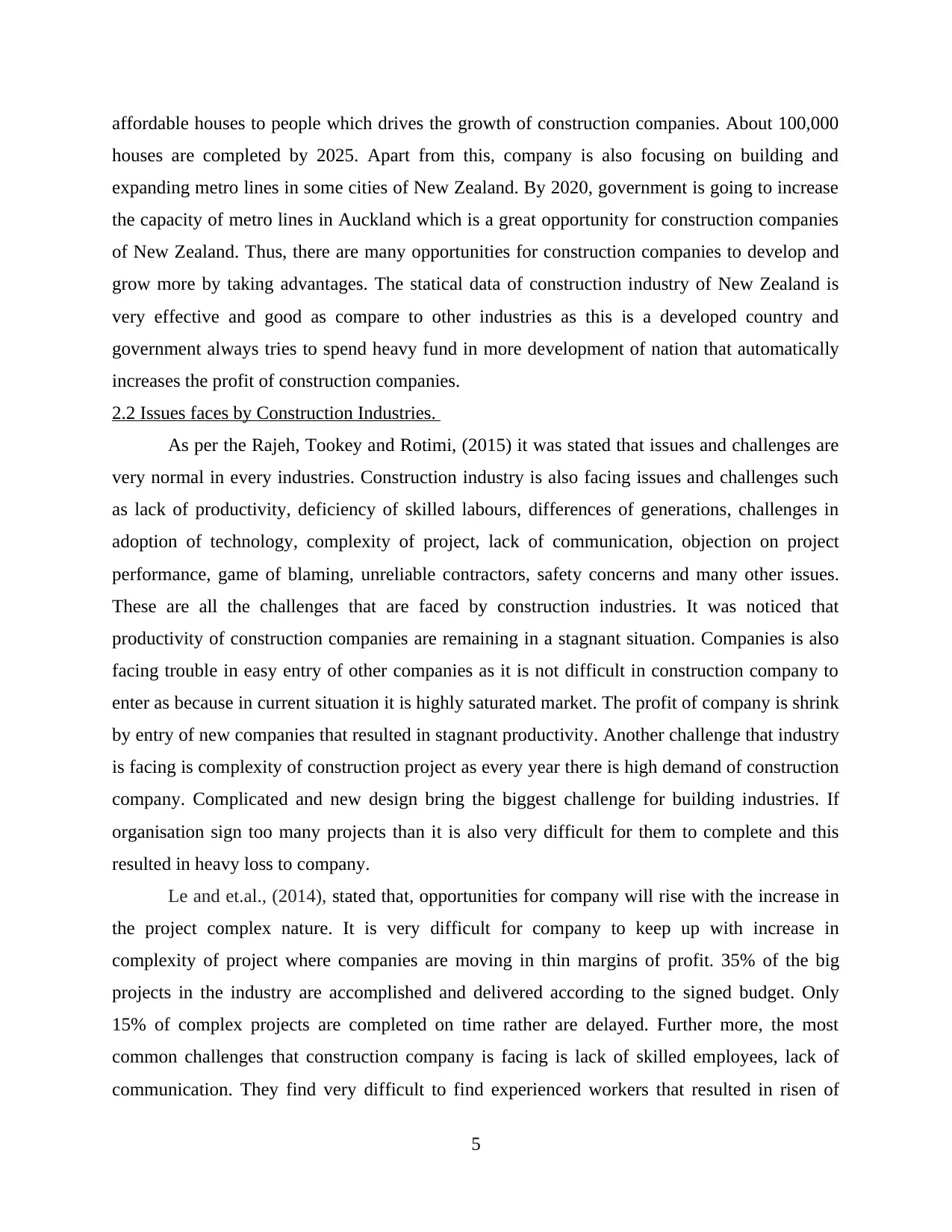
affordable houses to people which drives the growth of construction companies. About 100,000
houses are completed by 2025. Apart from this, company is also focusing on building and
expanding metro lines in some cities of New Zealand. By 2020, government is going to increase
the capacity of metro lines in Auckland which is a great opportunity for construction companies
of New Zealand. Thus, there are many opportunities for construction companies to develop and
grow more by taking advantages. The statical data of construction industry of New Zealand is
very effective and good as compare to other industries as this is a developed country and
government always tries to spend heavy fund in more development of nation that automatically
increases the profit of construction companies.
2.2 Issues faces by Construction Industries.
As per the Rajeh, Tookey and Rotimi, (2015) it was stated that issues and challenges are
very normal in every industries. Construction industry is also facing issues and challenges such
as lack of productivity, deficiency of skilled labours, differences of generations, challenges in
adoption of technology, complexity of project, lack of communication, objection on project
performance, game of blaming, unreliable contractors, safety concerns and many other issues.
These are all the challenges that are faced by construction industries. It was noticed that
productivity of construction companies are remaining in a stagnant situation. Companies is also
facing trouble in easy entry of other companies as it is not difficult in construction company to
enter as because in current situation it is highly saturated market. The profit of company is shrink
by entry of new companies that resulted in stagnant productivity. Another challenge that industry
is facing is complexity of construction project as every year there is high demand of construction
company. Complicated and new design bring the biggest challenge for building industries. If
organisation sign too many projects than it is also very difficult for them to complete and this
resulted in heavy loss to company.
Le and et.al., (2014), stated that, opportunities for company will rise with the increase in
the project complex nature. It is very difficult for company to keep up with increase in
complexity of project where companies are moving in thin margins of profit. 35% of the big
projects in the industry are accomplished and delivered according to the signed budget. Only
15% of complex projects are completed on time rather are delayed. Further more, the most
common challenges that construction company is facing is lack of skilled employees, lack of
communication. They find very difficult to find experienced workers that resulted in risen of
5
houses are completed by 2025. Apart from this, company is also focusing on building and
expanding metro lines in some cities of New Zealand. By 2020, government is going to increase
the capacity of metro lines in Auckland which is a great opportunity for construction companies
of New Zealand. Thus, there are many opportunities for construction companies to develop and
grow more by taking advantages. The statical data of construction industry of New Zealand is
very effective and good as compare to other industries as this is a developed country and
government always tries to spend heavy fund in more development of nation that automatically
increases the profit of construction companies.
2.2 Issues faces by Construction Industries.
As per the Rajeh, Tookey and Rotimi, (2015) it was stated that issues and challenges are
very normal in every industries. Construction industry is also facing issues and challenges such
as lack of productivity, deficiency of skilled labours, differences of generations, challenges in
adoption of technology, complexity of project, lack of communication, objection on project
performance, game of blaming, unreliable contractors, safety concerns and many other issues.
These are all the challenges that are faced by construction industries. It was noticed that
productivity of construction companies are remaining in a stagnant situation. Companies is also
facing trouble in easy entry of other companies as it is not difficult in construction company to
enter as because in current situation it is highly saturated market. The profit of company is shrink
by entry of new companies that resulted in stagnant productivity. Another challenge that industry
is facing is complexity of construction project as every year there is high demand of construction
company. Complicated and new design bring the biggest challenge for building industries. If
organisation sign too many projects than it is also very difficult for them to complete and this
resulted in heavy loss to company.
Le and et.al., (2014), stated that, opportunities for company will rise with the increase in
the project complex nature. It is very difficult for company to keep up with increase in
complexity of project where companies are moving in thin margins of profit. 35% of the big
projects in the industry are accomplished and delivered according to the signed budget. Only
15% of complex projects are completed on time rather are delayed. Further more, the most
common challenges that construction company is facing is lack of skilled employees, lack of
communication. They find very difficult to find experienced workers that resulted in risen of
5
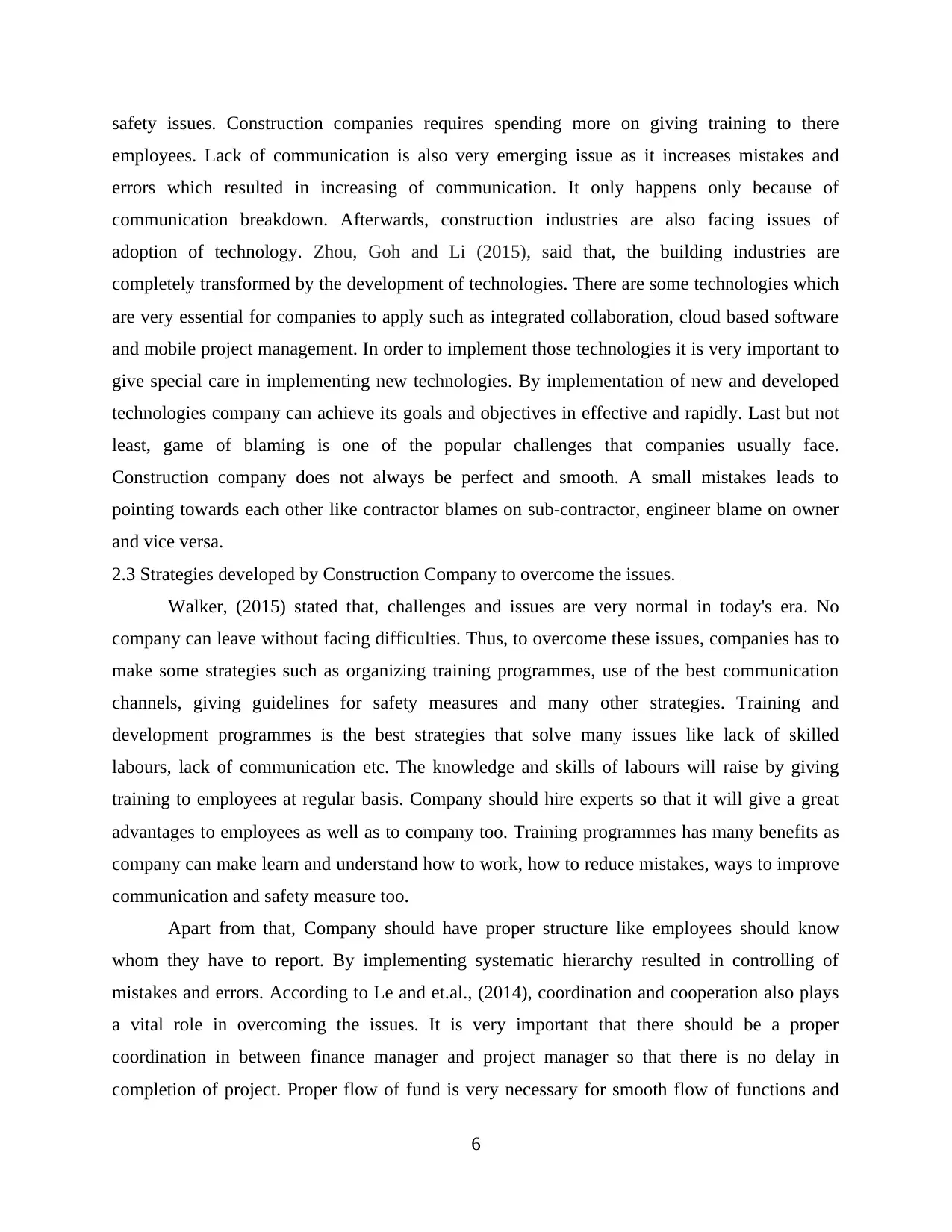
safety issues. Construction companies requires spending more on giving training to there
employees. Lack of communication is also very emerging issue as it increases mistakes and
errors which resulted in increasing of communication. It only happens only because of
communication breakdown. Afterwards, construction industries are also facing issues of
adoption of technology. Zhou, Goh and Li (2015), said that, the building industries are
completely transformed by the development of technologies. There are some technologies which
are very essential for companies to apply such as integrated collaboration, cloud based software
and mobile project management. In order to implement those technologies it is very important to
give special care in implementing new technologies. By implementation of new and developed
technologies company can achieve its goals and objectives in effective and rapidly. Last but not
least, game of blaming is one of the popular challenges that companies usually face.
Construction company does not always be perfect and smooth. A small mistakes leads to
pointing towards each other like contractor blames on sub-contractor, engineer blame on owner
and vice versa.
2.3 Strategies developed by Construction Company to overcome the issues.
Walker, (2015) stated that, challenges and issues are very normal in today's era. No
company can leave without facing difficulties. Thus, to overcome these issues, companies has to
make some strategies such as organizing training programmes, use of the best communication
channels, giving guidelines for safety measures and many other strategies. Training and
development programmes is the best strategies that solve many issues like lack of skilled
labours, lack of communication etc. The knowledge and skills of labours will raise by giving
training to employees at regular basis. Company should hire experts so that it will give a great
advantages to employees as well as to company too. Training programmes has many benefits as
company can make learn and understand how to work, how to reduce mistakes, ways to improve
communication and safety measure too.
Apart from that, Company should have proper structure like employees should know
whom they have to report. By implementing systematic hierarchy resulted in controlling of
mistakes and errors. According to Le and et.al., (2014), coordination and cooperation also plays
a vital role in overcoming the issues. It is very important that there should be a proper
coordination in between finance manager and project manager so that there is no delay in
completion of project. Proper flow of fund is very necessary for smooth flow of functions and
6
employees. Lack of communication is also very emerging issue as it increases mistakes and
errors which resulted in increasing of communication. It only happens only because of
communication breakdown. Afterwards, construction industries are also facing issues of
adoption of technology. Zhou, Goh and Li (2015), said that, the building industries are
completely transformed by the development of technologies. There are some technologies which
are very essential for companies to apply such as integrated collaboration, cloud based software
and mobile project management. In order to implement those technologies it is very important to
give special care in implementing new technologies. By implementation of new and developed
technologies company can achieve its goals and objectives in effective and rapidly. Last but not
least, game of blaming is one of the popular challenges that companies usually face.
Construction company does not always be perfect and smooth. A small mistakes leads to
pointing towards each other like contractor blames on sub-contractor, engineer blame on owner
and vice versa.
2.3 Strategies developed by Construction Company to overcome the issues.
Walker, (2015) stated that, challenges and issues are very normal in today's era. No
company can leave without facing difficulties. Thus, to overcome these issues, companies has to
make some strategies such as organizing training programmes, use of the best communication
channels, giving guidelines for safety measures and many other strategies. Training and
development programmes is the best strategies that solve many issues like lack of skilled
labours, lack of communication etc. The knowledge and skills of labours will raise by giving
training to employees at regular basis. Company should hire experts so that it will give a great
advantages to employees as well as to company too. Training programmes has many benefits as
company can make learn and understand how to work, how to reduce mistakes, ways to improve
communication and safety measure too.
Apart from that, Company should have proper structure like employees should know
whom they have to report. By implementing systematic hierarchy resulted in controlling of
mistakes and errors. According to Le and et.al., (2014), coordination and cooperation also plays
a vital role in overcoming the issues. It is very important that there should be a proper
coordination in between finance manager and project manager so that there is no delay in
completion of project. Proper flow of fund is very necessary for smooth flow of functions and
6
⊘ This is a preview!⊘
Do you want full access?
Subscribe today to unlock all pages.

Trusted by 1+ million students worldwide
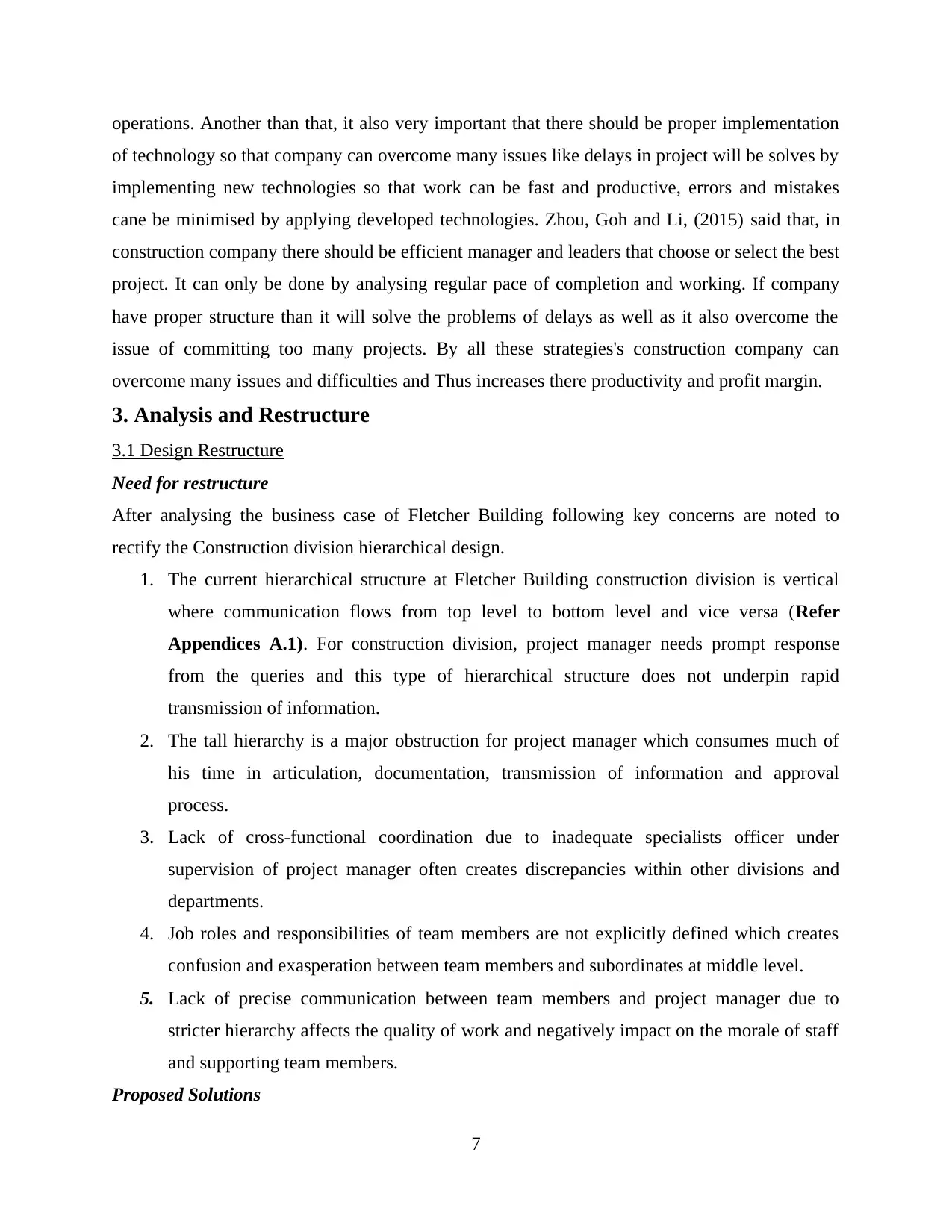
operations. Another than that, it also very important that there should be proper implementation
of technology so that company can overcome many issues like delays in project will be solves by
implementing new technologies so that work can be fast and productive, errors and mistakes
cane be minimised by applying developed technologies. Zhou, Goh and Li, (2015) said that, in
construction company there should be efficient manager and leaders that choose or select the best
project. It can only be done by analysing regular pace of completion and working. If company
have proper structure than it will solve the problems of delays as well as it also overcome the
issue of committing too many projects. By all these strategies's construction company can
overcome many issues and difficulties and Thus increases there productivity and profit margin.
3. Analysis and Restructure
3.1 Design Restructure
Need for restructure
After analysing the business case of Fletcher Building following key concerns are noted to
rectify the Construction division hierarchical design.
1. The current hierarchical structure at Fletcher Building construction division is vertical
where communication flows from top level to bottom level and vice versa (Refer
Appendices A.1). For construction division, project manager needs prompt response
from the queries and this type of hierarchical structure does not underpin rapid
transmission of information.
2. The tall hierarchy is a major obstruction for project manager which consumes much of
his time in articulation, documentation, transmission of information and approval
process.
3. Lack of cross-functional coordination due to inadequate specialists officer under
supervision of project manager often creates discrepancies within other divisions and
departments.
4. Job roles and responsibilities of team members are not explicitly defined which creates
confusion and exasperation between team members and subordinates at middle level.
5. Lack of precise communication between team members and project manager due to
stricter hierarchy affects the quality of work and negatively impact on the morale of staff
and supporting team members.
Proposed Solutions
7
of technology so that company can overcome many issues like delays in project will be solves by
implementing new technologies so that work can be fast and productive, errors and mistakes
cane be minimised by applying developed technologies. Zhou, Goh and Li, (2015) said that, in
construction company there should be efficient manager and leaders that choose or select the best
project. It can only be done by analysing regular pace of completion and working. If company
have proper structure than it will solve the problems of delays as well as it also overcome the
issue of committing too many projects. By all these strategies's construction company can
overcome many issues and difficulties and Thus increases there productivity and profit margin.
3. Analysis and Restructure
3.1 Design Restructure
Need for restructure
After analysing the business case of Fletcher Building following key concerns are noted to
rectify the Construction division hierarchical design.
1. The current hierarchical structure at Fletcher Building construction division is vertical
where communication flows from top level to bottom level and vice versa (Refer
Appendices A.1). For construction division, project manager needs prompt response
from the queries and this type of hierarchical structure does not underpin rapid
transmission of information.
2. The tall hierarchy is a major obstruction for project manager which consumes much of
his time in articulation, documentation, transmission of information and approval
process.
3. Lack of cross-functional coordination due to inadequate specialists officer under
supervision of project manager often creates discrepancies within other divisions and
departments.
4. Job roles and responsibilities of team members are not explicitly defined which creates
confusion and exasperation between team members and subordinates at middle level.
5. Lack of precise communication between team members and project manager due to
stricter hierarchy affects the quality of work and negatively impact on the morale of staff
and supporting team members.
Proposed Solutions
7
Paraphrase This Document
Need a fresh take? Get an instant paraphrase of this document with our AI Paraphraser
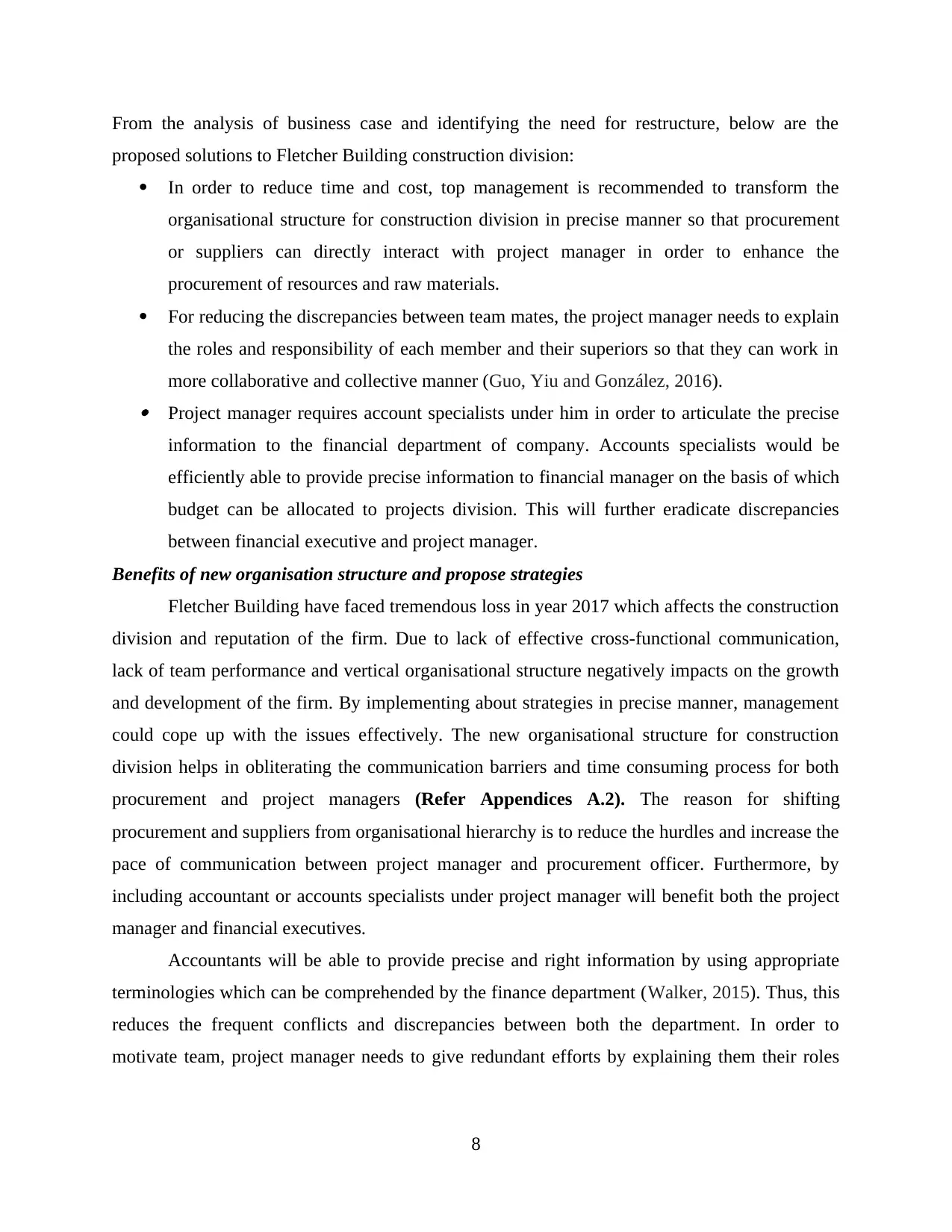
From the analysis of business case and identifying the need for restructure, below are the
proposed solutions to Fletcher Building construction division:
In order to reduce time and cost, top management is recommended to transform the
organisational structure for construction division in precise manner so that procurement
or suppliers can directly interact with project manager in order to enhance the
procurement of resources and raw materials.
For reducing the discrepancies between team mates, the project manager needs to explain
the roles and responsibility of each member and their superiors so that they can work in
more collaborative and collective manner (Guo, Yiu and González, 2016). Project manager requires account specialists under him in order to articulate the precise
information to the financial department of company. Accounts specialists would be
efficiently able to provide precise information to financial manager on the basis of which
budget can be allocated to projects division. This will further eradicate discrepancies
between financial executive and project manager.
Benefits of new organisation structure and propose strategies
Fletcher Building have faced tremendous loss in year 2017 which affects the construction
division and reputation of the firm. Due to lack of effective cross-functional communication,
lack of team performance and vertical organisational structure negatively impacts on the growth
and development of the firm. By implementing about strategies in precise manner, management
could cope up with the issues effectively. The new organisational structure for construction
division helps in obliterating the communication barriers and time consuming process for both
procurement and project managers (Refer Appendices A.2). The reason for shifting
procurement and suppliers from organisational hierarchy is to reduce the hurdles and increase the
pace of communication between project manager and procurement officer. Furthermore, by
including accountant or accounts specialists under project manager will benefit both the project
manager and financial executives.
Accountants will be able to provide precise and right information by using appropriate
terminologies which can be comprehended by the finance department (Walker, 2015). Thus, this
reduces the frequent conflicts and discrepancies between both the department. In order to
motivate team, project manager needs to give redundant efforts by explaining them their roles
8
proposed solutions to Fletcher Building construction division:
In order to reduce time and cost, top management is recommended to transform the
organisational structure for construction division in precise manner so that procurement
or suppliers can directly interact with project manager in order to enhance the
procurement of resources and raw materials.
For reducing the discrepancies between team mates, the project manager needs to explain
the roles and responsibility of each member and their superiors so that they can work in
more collaborative and collective manner (Guo, Yiu and González, 2016). Project manager requires account specialists under him in order to articulate the precise
information to the financial department of company. Accounts specialists would be
efficiently able to provide precise information to financial manager on the basis of which
budget can be allocated to projects division. This will further eradicate discrepancies
between financial executive and project manager.
Benefits of new organisation structure and propose strategies
Fletcher Building have faced tremendous loss in year 2017 which affects the construction
division and reputation of the firm. Due to lack of effective cross-functional communication,
lack of team performance and vertical organisational structure negatively impacts on the growth
and development of the firm. By implementing about strategies in precise manner, management
could cope up with the issues effectively. The new organisational structure for construction
division helps in obliterating the communication barriers and time consuming process for both
procurement and project managers (Refer Appendices A.2). The reason for shifting
procurement and suppliers from organisational hierarchy is to reduce the hurdles and increase the
pace of communication between project manager and procurement officer. Furthermore, by
including accountant or accounts specialists under project manager will benefit both the project
manager and financial executives.
Accountants will be able to provide precise and right information by using appropriate
terminologies which can be comprehended by the finance department (Walker, 2015). Thus, this
reduces the frequent conflicts and discrepancies between both the department. In order to
motivate team, project manager needs to give redundant efforts by explaining them their roles
8
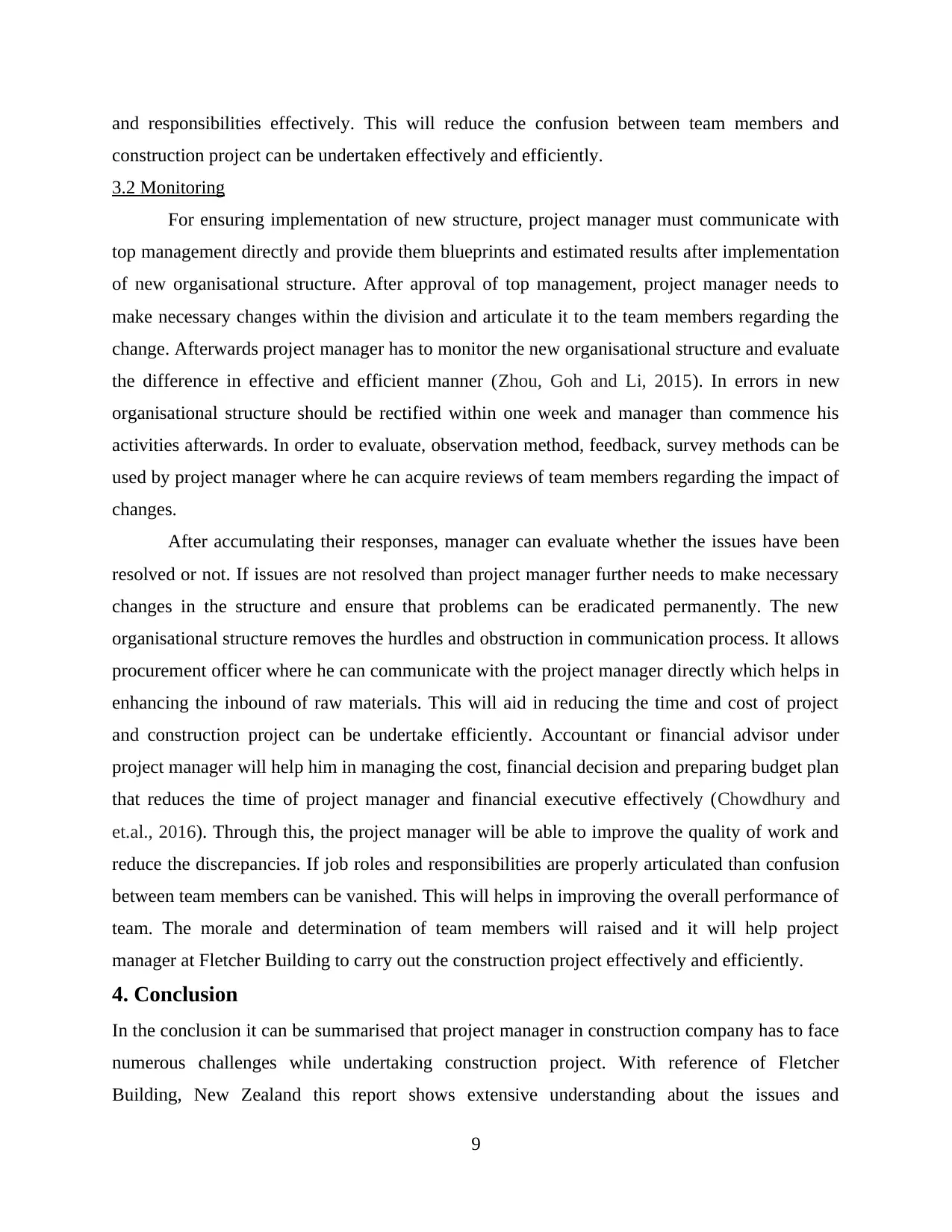
and responsibilities effectively. This will reduce the confusion between team members and
construction project can be undertaken effectively and efficiently.
3.2 Monitoring
For ensuring implementation of new structure, project manager must communicate with
top management directly and provide them blueprints and estimated results after implementation
of new organisational structure. After approval of top management, project manager needs to
make necessary changes within the division and articulate it to the team members regarding the
change. Afterwards project manager has to monitor the new organisational structure and evaluate
the difference in effective and efficient manner (Zhou, Goh and Li, 2015). In errors in new
organisational structure should be rectified within one week and manager than commence his
activities afterwards. In order to evaluate, observation method, feedback, survey methods can be
used by project manager where he can acquire reviews of team members regarding the impact of
changes.
After accumulating their responses, manager can evaluate whether the issues have been
resolved or not. If issues are not resolved than project manager further needs to make necessary
changes in the structure and ensure that problems can be eradicated permanently. The new
organisational structure removes the hurdles and obstruction in communication process. It allows
procurement officer where he can communicate with the project manager directly which helps in
enhancing the inbound of raw materials. This will aid in reducing the time and cost of project
and construction project can be undertake efficiently. Accountant or financial advisor under
project manager will help him in managing the cost, financial decision and preparing budget plan
that reduces the time of project manager and financial executive effectively (Chowdhury and
et.al., 2016). Through this, the project manager will be able to improve the quality of work and
reduce the discrepancies. If job roles and responsibilities are properly articulated than confusion
between team members can be vanished. This will helps in improving the overall performance of
team. The morale and determination of team members will raised and it will help project
manager at Fletcher Building to carry out the construction project effectively and efficiently.
4. Conclusion
In the conclusion it can be summarised that project manager in construction company has to face
numerous challenges while undertaking construction project. With reference of Fletcher
Building, New Zealand this report shows extensive understanding about the issues and
9
construction project can be undertaken effectively and efficiently.
3.2 Monitoring
For ensuring implementation of new structure, project manager must communicate with
top management directly and provide them blueprints and estimated results after implementation
of new organisational structure. After approval of top management, project manager needs to
make necessary changes within the division and articulate it to the team members regarding the
change. Afterwards project manager has to monitor the new organisational structure and evaluate
the difference in effective and efficient manner (Zhou, Goh and Li, 2015). In errors in new
organisational structure should be rectified within one week and manager than commence his
activities afterwards. In order to evaluate, observation method, feedback, survey methods can be
used by project manager where he can acquire reviews of team members regarding the impact of
changes.
After accumulating their responses, manager can evaluate whether the issues have been
resolved or not. If issues are not resolved than project manager further needs to make necessary
changes in the structure and ensure that problems can be eradicated permanently. The new
organisational structure removes the hurdles and obstruction in communication process. It allows
procurement officer where he can communicate with the project manager directly which helps in
enhancing the inbound of raw materials. This will aid in reducing the time and cost of project
and construction project can be undertake efficiently. Accountant or financial advisor under
project manager will help him in managing the cost, financial decision and preparing budget plan
that reduces the time of project manager and financial executive effectively (Chowdhury and
et.al., 2016). Through this, the project manager will be able to improve the quality of work and
reduce the discrepancies. If job roles and responsibilities are properly articulated than confusion
between team members can be vanished. This will helps in improving the overall performance of
team. The morale and determination of team members will raised and it will help project
manager at Fletcher Building to carry out the construction project effectively and efficiently.
4. Conclusion
In the conclusion it can be summarised that project manager in construction company has to face
numerous challenges while undertaking construction project. With reference of Fletcher
Building, New Zealand this report shows extensive understanding about the issues and
9
⊘ This is a preview!⊘
Do you want full access?
Subscribe today to unlock all pages.

Trusted by 1+ million students worldwide
1 out of 19
Your All-in-One AI-Powered Toolkit for Academic Success.
+13062052269
info@desklib.com
Available 24*7 on WhatsApp / Email
![[object Object]](/_next/static/media/star-bottom.7253800d.svg)
Unlock your academic potential
Copyright © 2020–2025 A2Z Services. All Rights Reserved. Developed and managed by ZUCOL.


